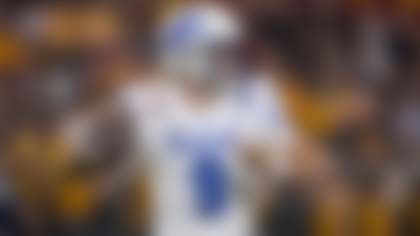As we head into the 2015 NFL campaign, Bucky Brooks is identifying which teams have improved the most in particular position groupings since the end of last season. Today's focus: defensive backfields.
5) Chicago Bears
The Monsters of the Midway haven't been the same since Lovie Smith's firing, but that should change with John Fox at the helm. The ex-defensive coordinator/secondary coach expects exceptional play from his defensive backfield. And Fox has brought in a veteran defensive staff that features superb teachers and tacticians, including D-coordinator Vic Fangio and secondary coach Ed Donatell. Thus, the Bears' defenders will not only be in a position to make more plays on the ball, but the attention to detail will lead to fewer breakdowns that result in explosive plays for the offense.
Free-agent signee Antrel Rolle's presence as the "MOF" (middle of the field) playmaker should discourage opponents from taking shots between the hashes. With another playmaking veteran (Tracy Porter) stepping in at nickel corner to round out a secondary that already features a pair of intriguing second-year defenders (Kyle Fuller and Brock Vereen) and a ballhawk (Tim Jennings), the Bears shouldn't field anywhere near as embarrassing a defense as last year's 30th-ranked sieve.
4) New Orleans Saints
Sean Payton wants to get the Saints back to playing championship football, but the offensive-minded head coach must receive better play from his defense, particularly the secondary. The unit was unable to disrupt the timing and rhythm of the opponent's passing game, allowing opposing quarterbacks to log a robust 92.9 passer rating against New Orleans. Granted, the Saints' inconsistent pass rush didn't help matters, but the perimeter defenders failed to harass receivers at the line or shut down passing lanes between the hashes.
The arrival of Brandon Browner gives the Saints a more physical presence at corner. The 6-foot-4, 221-pounder is a bully in coverage, relying on an ultra-aggressive style that overwhelms receivers. He will team with Keenan Lewis to give the Saints a pair of hard-nosed, physical cover men on the edges. Jairus Byrd hasn't hit the practice field yet, but Payton says that will happen "sooner than later." Last offseason's marquee free-agent signing managed just four games in 2014; when healthy, he shuts down passing lanes in the middle of the field as a crafty ballhawk with 22 career picks. If Kenny Vaccaro and Rafael Bush can settle into their roles as "MOF" enforcers and reduce the assignment errors that plagued the unit last fall, the Saints' secondary could rank as one of the best in the business by the season's end.
3) Philadelphia Eagles
While many remain skeptical about Chip Kelly's extreme makeover of the Eagles' roster, the third-year coach deserves credit for upgrading a secondary that struggled in every area a season ago. Philly's secondary surrendered the most explosive passing plays in football (yielding a league-worst 18 receptions of 40-plus yards) and allowed opposing quarterbacks to average 7.8 yards per pass attempt. All of this despite the fact that the Eagles boasted one of the best pass rushes in the league with 49 sacks (tied for second).
Consequently, the Eagles needed to overhaul their secondary and add more athletic defenders with superb man-to-man skills on the perimeter. Byron Maxwell comes over from the "Legion of Boom" to serve as the Eagles' CB1. Although he is probably most comfortable on the quarterback's blind side (RCB), Maxwell gives the Eagles a physical corner to challenge the likes of Dez Bryant, Odell Beckham Jr. and DeSean Jackson in the NFC East. Veteran Nolan Carroll and rookie Eric Rowe are fighting to start opposite Maxwell; right now it appears Carroll will get the nod, with Rowe manning the valuable nickel corner position. Offseason addition Walter Thurmond brings cover-corner skills to the free safety position. Even if he fails to cut the mustard as a starter, Thurmond gives the Eagles another sub-package defender to neutralize some of the three- and four-receiver sets opponents trot out in today's game.
2) Kansas City Chiefs
It is hard to suggest that the Chiefs' secondary, which ranked second against the pass in 2014, will be even better this season, but that's how I see it. The return of Pro Bowl safety Eric Berry and the addition of first-round pick Marcus Peters could make the unit nearly impossible to throw on this fall.
Berry, who was diagnosed with Hodgkin's Lymphoma last December, amazingly got back to the practice field last week. Prior to that diagnosis, this guy was one of the most dynamic safeties in the game, exhibiting exceptional cover skills, awareness and playmaking ability as a deep-middle player, as well as the grit and physicality needed to be an enforcer between the hashes. If he returns to form after shaking off the rust in training camp, Berry will help a unit that allowed just 6.4 yards per attempt in 2014 become even stingier this season. Peters was arguably the top cover corner in college football prior to a season-ending suspension that abruptly closed his career at Washington. He is a long, pesky defender with exceptional cover skills and a versatile game. He can shadow receivers utilizing bump-and-run, bail or off techniques, which is rare for a young player. If Peters can remain focused on the details, he eventually will team with Sean Smith to give the Chiefs a dynamic cornerback tandem on the edges. (Remember: Smith is suspended for the first three games of the season.)
1) New York Jets
The Jets' secondary has gone from horrendous to tremendous with the additions of Darrelle Revis, Antonio Cromartie, Buster Skrine and Marcus Gilchrist. The combination of Revis and Cromartie on the edges gives Todd Bowles the freedom to attack opponents with bump-and-run coverage on every down. Additionally, the duo gives the defensive wizard an opportunity to match up with elite receivers based on physical dimensions or style of play -- Cromartie can take the big receivers, with Revis handling the short, quick pass catchers. Skrine is one of the best sub-corners in football, exhibiting solid instincts and awareness as CB3. With three premier corners on the field, Bowles' blitz-heavy tactics could make it challenging for quarterbacks to string together completions on the perimeter.
Now, Gilchrist's arrival was overshadowed by the cornerback signings, but his presence as the "MOF" safety is a key part of the Jets' defensive plan. With a veteran assuming the communication duties, Calvin Pryor is free to "run and hit" as the box safety on early downs. Given Pryor's success as a thumper in Louisville, the Jets' offseason additions could help him reach his potential as a playmaker.
Overall, the Jets' roster retooling in the secondary could make "Gang Green" the top defense in football.
Follow Bucky Brooks on Twitter @BuckyBrooks.












